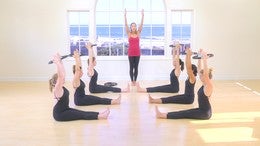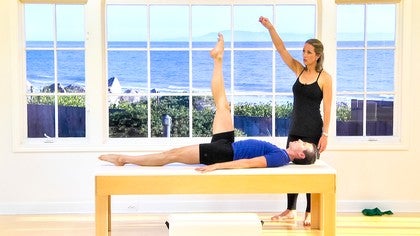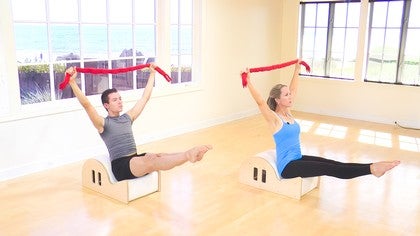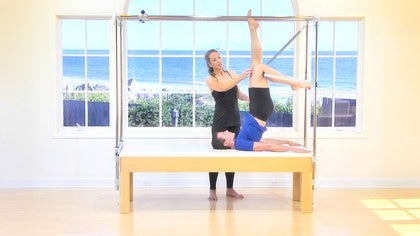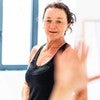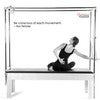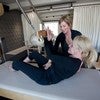Description
About This Video
Transcript
Read Full Transcript
So Brian to find the Fletcher per Casa breath is a breath that has a sound and a rhythm. It is the drummer he sent. Um, it's, it's a wonderful way of, of thinking of the breath, um, being the music for the movement. Um, the, the only issue with that is that people have been confused, I think more than anything about the sound that we make with the Fletcher percussive breath. And the sound is really the byproduct. It's, it's not the intention of the work. Um, the wonderful by-product is, is that it keeps the movement synchronized. For instance, in a group class when everyone is, is breathing audibly, everyone is moving at the same time. Um, it becomes easier for the teacher to correct movement. Um, but the, the sound is really the byproduct and the byproduct of narrowing the aperture of the exhalation. And so I just want to go through a very simple exercise that Susan sock developed. Um, she's one of Ron's longtime teachers. She's in palm springs and she'll be a part of this legacy project and it's simply going through an open aperture and narrowing the aperture. And then finally pressing the out the air out from behind the teeth and feeling how that engages the muscles of respiration differently, the deep abdominal muscles differently. And that's really what Ron was after. And so, um, what I'm going to ask David to do is just take a deep breath in and as he exhales, open the mouth and just try to press all their out.
And I want you to bend the flame of the candle, take a deep breath in and as you exhale, bend the flame of the candle. I noticed the difference and again, deep breath in and exhale. So it's a slightly narrower aperture and one more time, deep breath in and exhale. So that would be more of a pursed lip exhalation. The next tech solution that I'd like for you to try is pressing the air out from behind the teeth. Um, so there's not a lot of of work or force coming from here.
Think of the connection, um, being coming from the low abdominals and just to see how that works. Take a deep breath in and exhale and again, deep breath and notice what happens to his trunk. Notice what happens to a spine. Take a deep breath in. Yeah. And exhale last time, deep breath en. So notice that deeper engagement all the way down through the abdominals and notice how the spine actually lengthens as he exhales because he's pulling everything more closely into center.
So that's really the purpose of the Fletcher Per Casa Breath. Um, there is a sound to it. Um, but again, the sound is the byproduct of what we're trying to do, uh, to this part of the body, which is, which is ultimately what Joseph [inaudible] was after. Um, so the next thing I'd like to do is have David wrap the Diana band. You could use a yoga band, a flood, true towel around his ribs and just cross it over. And so we're emphasizing the lateral movement of the breath. Many of you I'm sure have done this exercise before. So as you take a deep breath, and I want him to think of initiating that inhalation from the back and stretching the dyna band three-dimensionally. And again, as he exhales along, gating the spine because everything's pulling into center. And again, deep breath into the back.
I Love Kathy Grant's image of breathing around a ball. Ron was after the same thing, so we wanna think of the breath going diagonally from the nose into the back, breathing around to the front. And then as we exhale, lifting up through the center of the body. And again, one more time. Deep breath in. Yeah, and to exhale, lifting up. And you can just bring your elbows down by your sides just a bit. Now let's just try the one lung breathing as Eve gentry called it, breathing into the right side, stretching the diet, Yvan to the right, and then exhale, pulling into center. Most of us have a tendency to breathe more into one side than the other. And think about what that does to this spine.
If we're doing that all day long date breath into this side and exhale, pulling in to center, try to make it a complete exhalation. One more time without getting the shoulders involved and exhale little harder for David to breathe into the left. Breathing in and out. And again, stretching the diet event to the left and out. Add a couple more times.
Breathing into the left and how this is possible. For those of you who don't believe it is and out and then breathing evenly into both sides and acts. Have a long game. Think of pulling the air in to your back. Exhale out of your belly.
Let's do that one more time. Pull the Aaron. Ron said, be greedy with your breath and exhale every bit of air. Nice. And release the dine event. How does that feel? Oxygen better than better than coffee, right? So now what I'd like for you to do is lie on your back, placing the feet flat on the Mat, and we'll line the heels up with the sits bones in this position. And it's, it's much easier to feel what's happening for the client to feel what's happening with their breath when they're, when they're in a supine position, especially if they have a tendency to extend the spine on inhalation. So what we're wanting to do is actually open the back on inhalation and along gate through the front on exhalation.
So I'm gonna place my hands right along side his posterior lateral ribs and ask him to breathe into the sides of the ribs. And the, he's as he exhales, draw the front of the ribs down the front of the body and try to feel that complete exhalation breathing in to the back and exhale down the front. Nice. So the next thing we're looking at is not only the lateral breath, but also the anterior posterior breath. So I'm gonna place my hand right on his sternum. And as he inhales, I want him to lift my hand up. And a CXC also want him to glide my hand down the front of his body. And it generally takes a client, four to eight repetitions to begin to feel this movement in their body.
We teach breath as an exercise. It's not just something that we layer onto movement, but it's an exercise in and of itself. And an act of breath works pretty much all of the muscles of the trunk. One more time. Deep breath in. And exhale, glide your sternum down the front of your body. Nice. So now what we'll begin to do is parse the air out. So oftentimes, um, those of you who've studied a little bit of the Fletcher work have heard the percussive breath and have thought that it's about the parsing of the air out.
Um, that's just part of it. Um, the pursing of the air out relates to breath volume and controls. So if we take four breaths and we want to be able to take four breaths out and equal measure, much like a measuring cup. So we're filling the lungs equally in four parts and then emptying the lungs equally in four parts. As we empty the lungs, we want to work progressively down the trunk of the body. So I'm going to ask David to breathe in. Let's start to take a deep breath in for to inhale and inhale and exhale.
Exhale and again. Oh, fun. Oh, fun and clothes and clothes. No threes in two, three and out to three [inaudible]. Again, open three and [inaudible]. Close to [inaudible]. Four breaths in.
Feel that lateral expansion and [inaudible] narrow the ribs all the way down the trunk. That's it. And again, O open or the pelvis down.
Now what I'd like for him to do is use the breath to go into a pelvic curl or a post teary or tilt on that fourth exhalation. So let's do that again and breathe in two, three and four and out to three. Curl the pelvis. Yes. And breathe in two, three, and four. And this time, yeah, as you exhale, I want you to length in the pelvis out onto the mat. Beautiful. And again, breathe in two, three and four and out two, three and curl [inaudible] it's hard. And again, grieve in two, three and four and out to [inaudible] place the pelvis.
Nice. How did that feel? Nice. Okay. Extend the legs out on the mat and in this position simply released the legs out to the sides and we'll go into what's called what we call Ron's imprinting. Um, so eve gentry had her version of imprinting, um, which is different than Ron's version. Um, as, as I understand it, eve was talking more about accessing the, the deep pair of spinal muscles and feeling that along vacation come from the back. Um, Ron taught it very much coming from the breath and the belly. Um, they're both after the same thing of actively elongating the spine without going into any sort of opposed terrier chills. So it's that a long [inaudible] of the spine that brings the spine closer to the mat. It's not a chuck of the pelvis. So I'm going to ask David to take a deep breath in. And as he exhales, try to work deeply through the abdominals and a long gate out of the hips.
And again, deep breath in and exhale and press down into the mat and make that a little more active. Deep breath in and exhale belly to the mat, elongating to the lower back. One more time. Deep breath in and exhale. So that's more through the lumbar spine. Now we'll work on engaging and imprinting more through the thoracic spine.
Take a deep breath in and exhale press. So this is coming more from the back muscles and again, deep breath in and engage from the bat. And again, deep breath in and press the back of the shoulders into the mat as you close the ribs. One more time. Deep breath in and exhale. And then alternating between the belly and the back.
Take a deep breath in and press the valley. Long shoe here. Deep breath in and press the back. Nice. And again, deep breath in and arrest the valley. One more time. Deep breath in. This is a subtle movement, but it's amazing what it does to the spine. It's a great prep from that work.
So from here, I'd like for him to draw his legs together and let's again, um, let's lift the arms up and come to a roll up position and curling all the way up. Rounding the spine forward show. What I'd like to do is just go through how the breath informs the movement. I'm looking at a few Maddix, resizes civil start with the rollout in point the toes. Exhale, pull back through the ways and then take a full breath to roll the spine down and extend the arms out behind you so it's a little slower and a little more controlled than maybe you're used to doing. Inhale, lift the arms, flex the Fi, exhale into an African traction and that a full breath to peel the spine forward into a spine stretch position in point, lengthening out of the hips.
And then use your breath to stretch your back all the way out and you can see how deeply that breath works through center of the body. One more time, lift up or contraction, full breath. So it's no mystery that it's the center of the body doing the work, not the shoulders point and rolling down and like an all the way out and stretch. Lift the arms up and press your arms down by your sides. And let's just try one leg in and extend that like up to the ceiling. So we'll do very small leg circles here. Again, using the breath instead of the momentum to guide the work.
Inhale Cra and uh, across and uh, that's it. Sinking into the ballet and again across and uh, last one and uh, and reverse the movement all open. And so you can feel the breath stirring the leg around and last one and up. Lengthen the leg and lower all the way down. Lifting the arms, come into an upper contraction, peeling the spine forward and then rolling up to a seated position, opening the arms out to a t position and separate the legs to a v position. Let's use the breath to rotate the spine. Inhale, rotate.
And then exhale, pull century using your breath. And again, breathing in to the left to rotate to the right. Exhale, pull center. So it's the breath that's guiding the movement, not the movement. And exhale, center and again, rotating as centered. Rotate to the left and contract forward into a saw. Inhale, lift up, maintaining the rotation. Exhale setting. And again, use your breath to propel you around.
Exhale into the SA, opening the chest. Inhale, lift and exhale center. And let's go into the three saws, which is more classically what you say. And rage, rage, rage and lift up and pull center and rotate further, further lift and whole Saturn. Again, reaching the arms forward. So let's go into the next exercise. Reaching arms forward. Draw the legs together and roll down.
Opening at the heads all the way down. Arms down by your sides. Follow the like, send to a tabletop position. And here, so we'll use the precaster breath again to show that the hundreds, and this is a progressive hundred developed by Ron. Um, the reason he developed the progressive hundred as he felt that when we went straight out into the hundreds position, can you curl forward straight out? The tendency was to hold the legs up from the hip flexors rather than placing the pelvis down and feeling that wonderful along geishas through the lumbar spine. So by starting in the 90 90 position, working up to 90 working all the way out, it really emphasized the placement of the pelvis and the work through the trunk. So let's lift the arms up to the ceiling and curl the upper body forward. Good. And let's just breathe in for two and out for two and notice how clear the movement and the breath work together. And he used to set to extend the legs up to the ceiling, maintaining that clear movement.
You can see the breath in the trunk, kind of just slower the legs down, a third feeling the reachout of the hip and then lower down another third, reaching longer, keeping the separate countries.
Set work for brass knife. Hold it there. Full breaths for extended legs long to the Mat. And it is keeping your arms down by your sides. Lengthen all the way up. Beautiful. David. Thank you. So I hope that gives you a sense of how the breath does, doesn't take us away from the classical work. And if anything, it deepens the, the, the awareness and the intention, the precision, um, that we're after in a [inaudible] program.
It's all about working more deeply through the core of the body. It has very little to do with the sound. Um, and, and I would, I would try it, play with it, um, and see how the breath can, can really help guide the movement, lead the movement instead of being an afterthought. Um, so that's an introduction to the Pletcher percussive breath.
Pilates Legacy Project: Ron Fletcher Methods
Comments
Wonderful video on the percussive breath, thank you.
Ron's Imprinting piece, I find this challenging, in a good way. When you talk of elongating the spine without a posterior tilt at 12:03, my experience was I could sensate a lot of muscular movement but not so much the elongation of my spine.
So I placed my hand on my head whilst doing this piece so as to see if I could feel it the that way. There was a difference in pressure on my hand so I knew that I was elongating, it's like you say, very subtle.
So my question is, the elongation your talking of is it because your lengthening out the lumbar curve with core control? If you just tilt the pelvis posteriorly to try and lengthen the spine that way it feels like a shortening of the frontline of the body. Was Ron Fletcher after axial elongation thought the back line of the body with core control but accessed it through breath and the front of the body? Is that what the piece is about?
You need to be a subscriber to post a comment.
Please Log In or Create an Account to start your free trial.
